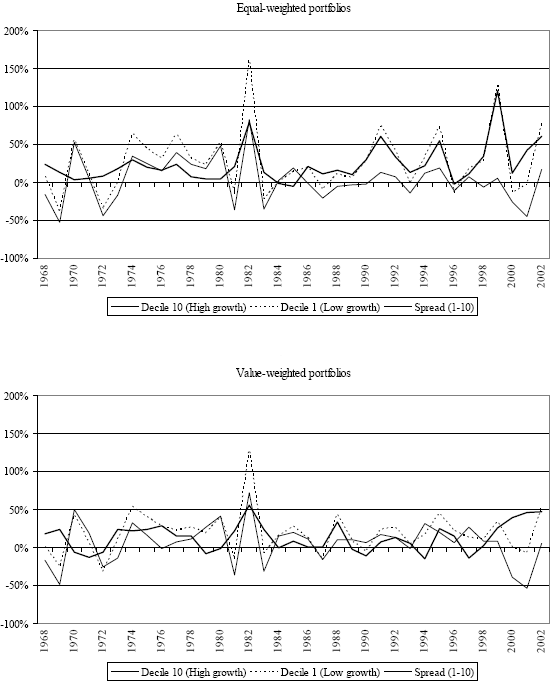Does strong (weak) past growth in a company’s total assets predict high (low) future stock returns? Or, does investor overreaction to past data predict the opposite? In the July 2007 update of their paper entitled “Asset Growth and the Cross-Section of Stock Returns”, flagged by a reader, Michael Cooper, Huseyin Gulen and Michael Schill examine the relationship between firm asset growth (year-on-year percentage change in total assets) and subsequent stock returns. Using firm fundamentals and stock return data for all non-financial U.S. public companies over the period 1968-2003, they conclude that:
- There is a strong negative correlation between past asset growth and subsequent abnormal stock returns. Raw value-weighted returns for the 10% of firms with the lowest (highest) past asset growth rates average 18% (5%) annually. (See the chart below.)
- With standard risk adjustments, equal-weighted portfolios of firms with low (high) past asset growth rates earn future average returns of 9.1% (-10.4%), a highly significant spread of 19.5%. Capitalization weighting reduces the average spread to 8.4% per year.
- This asset growth effect persists well beyond the next year, offering abnormal returns
up to five years after the sorting year. - The effect is consistent, with low asset growth stocks beating high asset growth stocks in 91% (71%) of sample years on an equal-weighted (value-weighted) basis.
- Although the effect is particularly strong for small companies, it is also significant among large-capitalization firms.
- The asset growth effect is generally stronger than book-to-market, firm capitalization, momentum and other growth measure effects (especially for large-capitalization firms). The Sharpe ratio of annual returns for a value-weighted hedge portfolio is 1.07 for asset growth, 0.37 for book-to-market, 0.13 for firm size and 0.73 for momentum.
- The components of total assets that drive the effect most strongly are changes in operating assets and changes in debt and stock financing. Growth in debt (stock) financing has the strongest effect form small and medium-size (large) firms. The asset growth effect partially explains the secondary issuance/repurchase anomaly.
- Investors appear to overreact to past firm growth rates.
The following chart, taken from the paper, shows 12-month returns for equal-weighted and value-weighted portfolios constructed annually based on past asset growth rates for 1968-2002. Decile 1 (10) consists of firms among the 10% lowest (highest) asset growth rates. The spread is the return for low-growth stocks minus the return for high-growth stocks. It shows that low-growth beats high-growth in all but three (1984: -1%; 1985: -5%; 1996: -2%) of 35 years for equal-weighted portfolios.

In summary, consistent with the interpretation that investors over-extrapolate past trends, last-year change in firm assets is among the most economically and statistically significant predictors of next-year returns for individual U.S. stocks. On average, stocks of companies with low growth last year consistently outperform stocks of companies with high growth last year.